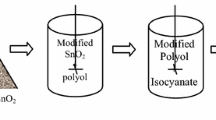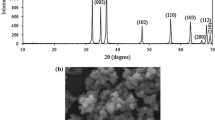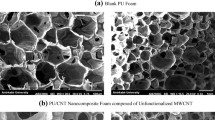Abstract
In the current study, flexible polyurethane foam was reinforced with different contents of SiO2 nanoparticles (0.5–2 wt%). Compression test was performed in a range of strain rates (1–20 min−1), and compression set test was also done at different temperatures. Results showed that addition of SiO2 nanoparticles improved compression properties of PU foam and the sample with 0.5 wt% SiO2 nanoparticles exhibited the highest mechanical performance with about 180 and 40% improvements in the compressive plateau and densification stress. Strain rate was showing a positive effect on these parameters with the enhancements of 360 and 90%. It was also shown that the temperature had a remarkable effect on compression set behavior of nanocomposite as the values change from 0.5% at − 20 °C to near 79% at 100 °C. Finally, microscopy micrographs confirmed the appearance of larger cell pores and a greater tendency for incomplete cell opening with increasing SiO2 content.








Similar content being viewed by others
References
Mahfuz H, Uddin MF, Rangari VK, Saha MC, Zainuddin S, Jeelani S (2005) High strain rate response of sandwich composites with nanophased cores. Appl Compos Mater 12:193–211
Balch DK, O’Dwyer JG, Davis GR, Cady CM, Gray GT, Dunand DC (2005) Plasticity and damage in aluminum syntactic foams deformed under dynamic and quasi-static conditions. Mater Sci Eng A 391:408–417
Lee LJ, Zeng C, Cao X, Han X, Shen J, Xu G (2005) Polymer nanocomposite foams. Compos Sci Technol 65:2344–2363
Saha MC, Kabir ME, Jeelani S (2009) Effect of Nanoparticles on mode-I fracture toughness of polyurethane foams. Polym Compos 30:1058–1064
Bernal MM, Molenberg I, Estravis S, Rodriguez-Perez MA, Huynen I, Lopez-Manchado MA, Verdejo R (2012) Comparing the effect of carbon-based nanofillers on the physical properties of flexible polyurethane foams. J Mater Sci 47:5673–5679
Artavia LD, Macosko CW (1990) Foam kinetics. J Cell Plast 26:490–511
Elwell MJ, Ryan AJ, Grunbauer HJM, VanLieshout HC (1996) An FT I.R. study of reaction kinetics and structure development in model flexible polyurethane foam systems. Polymer 37:1353–1361
Sonnenschein MF, Prange R (2007) Mechanism for compression set of TDI polyurethane foams. Polymer 48:616–623
Coons JE, McKay MD, Hamada MS (2006) A Bayesian analysis of the compression set and stress–strain behavior in a thermally aged silicone foam. Polym Degrad Stab 91:1824–1836
Jaunich M, Stark W, Wolff D (2012) Comparison of low temperature properties of different elastomer materials investigated by a new method for compression set measurement. Polym Test 31:987–992
Koberstein JT, Galambos AF, Leung LM (1992) Compression-molded polyurethane block copolymers. 1. Microdomain morphology and thermomechanical properties. Macromolecules 25:6195–6204
Moreland JC, Wilkes GL, Turner RB (1994) Viscoelastic behavior of flexible slabstock polyurethane foams: dependence on temperature and relative humidity. I. Tensile and compression stress (load) relaxation. J Appl Polym Sci 52:549–568
Slater C, Davis C, Strangwood M (2011) Compression set of thermoplastic polyurethane under different thermal-mechanical-moisture conditions. Polym Degrad Stab 96:2139–2144
Skorpenske RG, Solis R, Kuklies RA, Schrock AK, Turner RB (1992) Compression set mechanisms in flexible polyurethane foam. Proc SPI Annu Tech Mark Conf 34:650–659
Chen L, Schadler LS, Ozisik R (2011) An experimental and theoretical investigation of the compressive properties of multi-walled carbon nanotube/poly(methyl methacrylate) nanocomposite foams. Polymer 52:2899–2909
Antonietti M, Goltner C (1997) Superstructures of functional colloids: chemistry on the nanometer scale. Angew Chem Int Ed Engl 36:910–928
Bandarian M, Shojaei A, Rashidi AM (2011) Thermal, mechanical and acoustic damping properties of flexible open-cell polyurethane/multi-walled carbon nanotube foams: effect of surface functionality of nanotubes. Polym Int 60:475–482
Berta M, Lindsay C, Pans G, Camino G (2006) Effect of chemical structure on combustion and thermal behaviour of polyurethane elastomer layered silicate nanocomposites. Polym Degrad Stab 91:1179–1191
Cao Y, Lai Z, Feng J, Wu P (2011) Graphene oxide sheets covalently functionalized with block copolymers via click chemistry as reinforcing fillers. J Mater Chem 21:9271–9278
Verdejo R, Stampfli R, Alvarez-Lainez M, Mourad S, Rodriguez-Perez MA, Bruhwiler PA, Shaffer M (2009) Enhanced acoustic damping in flexible polyurethane foams filled with carbon nanotubes. Compos Sci Technol 69:1564–1569
Yang Y, Gupta MC, Dudley KL, Lawrence RW (2005) Novel carbon nanotube–polystyrene foam composites for electromagnetic interference shielding. Nano Lett 5:2131–2134
Thirumal M, Khastgir D, Singha NK-, Manjunath BS, Naik YP (2007) Mechanical, morphological and thermal properties of rigid polyurethane foam: effect of the fillers. Cell Polym 26:245–259
Chen I, Ozisik R, Schadler LS (2010) The influence of carbon nanotube aspect ratio on the foam morphology of MWNT/PMMA nanocomposite foams. Polymer 51:2368–2375
Widya T, Macosko CW (2005) Nanoclay-modified rigid polyurethane foam. J Macromol Sci B Phys 44:897–908
Daniel IM, Cho JM, Werner BT (2013) Characterization and modeling of stain-rate-dependent behavior of polymeric foams. Compos A Appl Sci Manufacturing 45:70–78
Moghim MH, Zebarjad SM (2016) Effect of strain rate on tensile properties of polyurethane/multi-walled carbon nanotube nanocomposite. J Vinyl add Technol 22:356–361
Gómez-del Río T, Rodríguez J (2012) Compression yielding of epoxy: strain rate and temperature effect. Mater Des 35:369–373
Shadlou S, Ahmadi-Moghadam B, Taheri F (2014) The effect of strain-rate on the tensile and compressive behavior of graphene reinforced epoxy/nanocomposites. Mater Des 59:439–447
Author information
Authors and Affiliations
Corresponding author
Rights and permissions
About this article
Cite this article
Moghim, M.H., Keshavarz, M. & Zebarjad, S.M. Effect of SiO2 nanoparticles on compression behavior of flexible polyurethane foam. Polym. Bull. 76, 227–239 (2019). https://doi.org/10.1007/s00289-018-2384-0
Received:
Revised:
Accepted:
Published:
Issue Date:
DOI: https://doi.org/10.1007/s00289-018-2384-0




